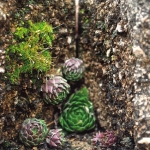Today’s One Picture a Day is an experiment in post-processing. The subject is a crevice in a landscaping block wall. We put the wall in about ten years ago. Inside the angular crevices of the wall we have placed “hens and chickens,” also called “cats and kittens” and a variety of other names. This succulent, evergreen plant is very hardy. It reproduces through offsets. Technically, they are members of the flowering plant family Crassulaceae. I have no idea what species ours are. They are ideal for naturalizing a rock wall. This rock wall is also attracting some native flora on its own, especially mosses. The mosses must like it, as well, because they are putting up reproductive structures (the fine hair-like things above the main body of the moss.) It is fun to explore the crevices in this wall. The picture is a miniature landscape within one of those crevices.
We took the photograph with the express purpose of manipulating it in post-processing. The light was very flat on this cloudy day. The flat light was nice for avoiding harsh shadows that can be in tight spaces like this rock wall. However, it also produced a picture that was overall flat in camera. To make sure we had all post-processing options on the table, we took this picture in RAW format. In camera I used “vivid” saturation with a slight bump in sharpness. However, since we were shooting RAW, this was a moot point as those settings are not a permanent part of the image like they would be if we shot in JPEG.
We have three versions of the image for you to compare. Version one is the original, straight from the camera. Version two is Aperture’s “auto-enhance” on factory settings. Version three, and the featured image for this post is the our manual version.
For the manual version, the biggest improvement came from using the White Balance setting. Since there many choices for “neutral gray” in this picture, I just slide the eye dropper selector around; Aperture live-previewed as I did so. I stopped on something that looked good to me. I also bumped the sharpness and contrast further. I made a few other tweaks, but those seemed to make the biggest improvements. I don’t have a good grasp on exactly what all the controls can do. I just play until I think I’m done.
The camera was a Nikon D90, with the 18-55mm VR kit lens.




